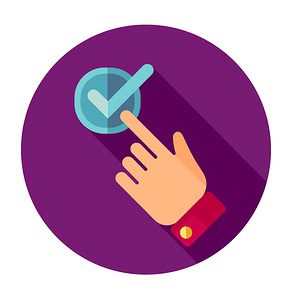
Things seem to be going pretty well. You’ve been adding social followers, getting good reviews, and feeling positive about business overall. All signs point to some killer customer success, right? Maybe. Or maybe not. The only way to really know is if you’re measuring it.
Once you start to track how you’re performing with customers, you can begin to implement strategies to help your company get even better in those areas. As the famous Peter Drucker quote goes, “If you can’t measure it, you can’t improve it.”
To help you start tracking your own customer success, we’ve put together a list of four tools that will give you a real understanding of how you’re doing.
1 Survey feedback
 One of the best ways to dig deep into how your customers feel about your company is with a survey. These can cover as much or as little as you want, but you’ll want to aim for a survey that takes under five minutes (about 10 questions) to complete — unless you’re offering a gift in return for their feedback.
One of the best ways to dig deep into how your customers feel about your company is with a survey. These can cover as much or as little as you want, but you’ll want to aim for a survey that takes under five minutes (about 10 questions) to complete — unless you’re offering a gift in return for their feedback.
Your survey questions should be concise and focus on how customers view their relationships (or lack thereof) with your business. Some examples of questions include:
- What do you like best about our services?
- What do you like the least, or what would you change?
- Would you refer us to a friend? Why or why not?
Your goal should be to get a sense of what your customers think about your company, if they’re having a favorable experience, and if not, what would make it better. You can send the email out in your regular newsletter, create a landing page for it on your site, or share the link on social media.
There are more than a dozen survey tools you can use to build, send, and monitor your questionnaire, and most offer some sort of free plan. Find the one that best meets your needs and send out a survey or two.
2 Net promoter score
 A type of survey, a net promoter score (NPS) is when you ask customers a single question. So, it takes a loss less time to plan the question and review the results. You might not get the same amount of depth with the answers compared to a full survey, but you’ll get more engagement because of the short format.
A type of survey, a net promoter score (NPS) is when you ask customers a single question. So, it takes a loss less time to plan the question and review the results. You might not get the same amount of depth with the answers compared to a full survey, but you’ll get more engagement because of the short format.
The NPS can use numbers (ex. 1-10), stars, or even smiley faces to allow customers to pick how they’d rate your product or services. Here are examples of questions to ask with an NPS:
- How satisfied are you with our product/service?
- How likely are you to recommend our company?
The results will show how your customers would rate your business. Respondents can be classified in three categories based on the score they give: detractors (0-6), passive (7-8), or promoters (9-10).
The goal should be to increase your number of promoters and figure out how you can improve the others’ ratings. If you receive a low rating, follow up with them to see what you can do better and if they have issues you can resolve. You can post the NPS on your site or send it out via email to get your customers’ feedback.
3 Churn rate
One term you’re probably well acquainted with is “churn.” Although this metric normally doesn’t show you why a customer left, it does help you figure out how many new acquisitions you need to make up for the loss and how you’re performing year-over-year.
To calculate your churn rate, look at the percentage of customers who left your business during a specific time frame: That could be a month, quarter, or year, depending on which structure works best for your team.
Start with the number of customers you lost in a month, for example, and divide that by the number of customers you had at the beginning of the previous month — and that will give you your churn rate percentage.
While any amount of churn isn’t great, most experts seem to agree a rate of 5 to 7 percent annually is acceptable. That’s a good benchmark to use to get a better idea of how your company compares to others.
4 Customer health score
 Think of it as a customer checkup: You’re pulling in all of the data you have on them to see how healthy of a relationship you have with them. It’s a culmination of all of your tracking efforts and can include a variety of customer success components.
Think of it as a customer checkup: You’re pulling in all of the data you have on them to see how healthy of a relationship you have with them. It’s a culmination of all of your tracking efforts and can include a variety of customer success components.
Here are a few metrics you can include in your customer health score:
- Email open/read rates
- Length of time as a customer
- Number of purchases and/or upsells
- Survey feedback
- Social media engagement
- Use of product/service
And that list is really just the tip of the iceberg of things you can include in the health assessment. Customize it to be in line with your customer goals. You can either pull the information manually — maybe for just 100 customers — or use your CRM’s automation functions, when possible.
It may take more time than some of the other measurement approaches, but you’ll get a clearer view of how customers are interacting with you. When you identify high-performing customers, they can become your VIPs, who you can shower with some extra benefits.
Focus your efforts on customer success
How you define customer success is really up to your organization, so implement the right tools and procedures to help you measure and improve the things that make sense for your team. The important thing is it that you continue tracking your progress — not just to keep customers happy, but also for your bottom line.
According to venture capitalist Jason Lemkin, “Customer success is where 90 percent of the revenue is.” So make sure you aren’t leaving any money on the table.
Once you figure out what is and isn’t working from your customer’s point of view, take action to provide the best experience and relationship possible. The information you gather from tracking your customer success really can transform the way you do business, so start putting it to good use.
How do you measure customer success? Share your tips in the comments below!
Lauren Dowdle is an award-winning writer based in Nashville, Tenn. Her decade-long writing career has covered everything from landscaping to marketing.

